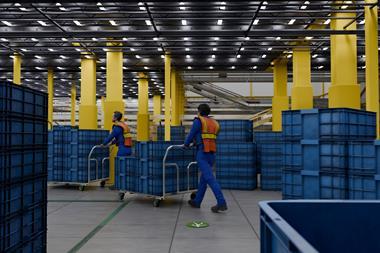The explosion of multichannel is making retailers reconsider everything, from where they want their stores to be, to the kind of shops they should be.

The combination of clicks and bricks is dramatically increasing the complexity of location decisions, and retailers are being forced to re-evaluate not only the number of stores in their portfolios but whether the metrics by which they determine the best locations still hold true.
Hobbycraft chairman Simon Burke said last year, in an age of multiple channel transaction journeys, the key is to find a way of evaluating “customer performance, not store performance”.
Such thinking is blurring the lines between the physical and digital space and what the role of real estate is within a business. The nature of stores is changing - in the past couple of years we’ve had pure-play etailers opening shops, multichannel retailers experimenting with online-oriented stores and grocers leveraging in-store loyalty through technology.
As with much in the multichannel world, the answer is different for every retailer. Department store group John Lewis says it is considering click-and-collect-only stores, based on the success of its omnichannel approach and its use of sister retailer Waitrose as a base for many of its collection points. John Lewis head of omnichannel development Karen Dracou says click-and-collect has highlighted the benefit of its stores. Up to 35% of online orders are fulfilled through click-and-collect, driven in part by the addition of Waitrose stores as collection points.
Where once John Lewis expected national coverage to come via a network of large department stores, the retailer is now happy to take a more flexible approach. This is evidenced at Exeter, where John Lewis used technology such as iPads and touchscreens to provide the same in-store assortment in a 60,000 sq ft space as is available in the full-line 250,000 sq ft John Lewis stores. However, Dracou notes that all things are not equal and that the Exeter experience also illustrates that the content for web shoppers needs to be tweaked for in-store users.
She also believes there is scope for click-and-collect-only stores, similar to rival House of Fraser’s two test stores in Liverpool and Aberdeen.
John Lewis is also piloting a tie-up with delivery and collection point specialist Collect+, which will provide the retailer with about 5,000 click-and-collect locations nationally. It is, the retailer admits, a risk to hand over brand management of the collection experience to a third party, but the advantages are clear and Collect+ also scored a coup by opening a collection point at Meadowhall in Sheffield late last year.
Others are also looking to reposition their estates. Argos managing director John Walden says the retailer is investing £300m in the first three years of a five-year strategy that will involve sweeping changes to stores. The programme includes the replacement of in-store technology for ordering goods and the improvement of the queueing system, as well as extension of the range and offering same-day or next-day delivery. Yet Walden insists retention of Argos’ 740 stores is integral to this strategy. “We’ll take advantage of our national chain and we’ll reposition them as points of collection and of great customer experience,” he says.

Multichannel is not the only factor changing the way store locations are determined. London has been less affected by the economic crisis than many areas, and rents are high and demand often outweighs supply. Major cities across the UK and satellite towns in the South and Southeast may well be the chief beneficiaries of that. BNP Paribas Real Estate senior director and head of retail investment Simon Williams says despite the phenomenal rise in demand for prime retail real estate in London, there is a sense that better value might be found outside London: “The next ports of call will inevitably be the other major conurbations so Manchester, Birmingham, Liverpool and the like will be the next targets. We expect to see more of a spread of openings this year.”
Yvonne Court, partner for cross-border retail at Cushman & Wakefield, maintains that regardless of the complexity of omnichannel retailing, the fundamentals of location remain:”There seems little doubt that the top-tier cities will increasingly be seen as gateway cities for new and expanding brands,” she says.
“A lot of what is being discussed in terms of the way multichannel is changing property requirements is in fact tangled up with the impact of the recession. For retailers, separating a changing world from the effects of low consumer confidence is very difficult.”
BNP Paribas also notes that affluent commuter towns in the South and Southeast could benefit from the high rents in London, with many of those locations essentially serving a consumer base with similar attributes to the capital. BNP Paribas director of retail Patrick Heaps says: “There are some great retailers, such as The White Company, which have done very well in the UK’s affluent market towns and there is no reason to think that more brands couldn’t exploit the opportunities.”
Ben Grose, head of Europe at British Land, points to “dominance” as the common factor among popular retail destinations. He says it is destinations that dominate a category, rather than the category itself, that are successful.
“Whether it’s a shopping park or a shopping centre, if it is dominant in the catchment hierarchy then retailers are more willing to add such a destination to their portfolio,” he adds.
“Consumers want a great offer and convenience, which is why you are seeing so much development of food and beverage, for example. It is also why you are seeing retailers prepared to open in a variety of locations, and of course why out of town is performing well.”
Some pure-play retailers have joined the ranks of those prepared to break out of their silos, and store requirements are continuing to evolve as etailers enter the market. Kiddicare is rolling out a network of flagship stores, and others, including Net-a-Porter, have dabbled with store-based initiatives, such as a window shop on Bond Street with images of products which consumers can use their mobile phones to buy.

Mail order and internet retailer N Brown is now running a trial of seven stores that give it a multichannel proposition. Marketing director Paul Kendrick says the company does not view these stores as simply profit centres - rather, the idea is to evaluate the level of online sales that the outlets also drive within their catchment areas.
“There is an awful lot of hype still,” says Court. “Retailers need to decide what’s appropriate for them and what sort of experience they can deliver. What retailers and shopping centres need to do is harness the technology and make it work for their location.”
As multichannel shopping continues to make its mark on the retail industry, the criteria for store locations will keep changing. No matter what channel they started in, retailers will need to work hard on ensuring their stores remain relevant.


























No comments yet